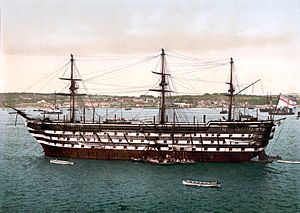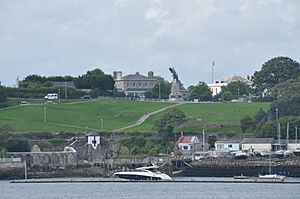Commander-in-Chief, Plymouth facts for kids
Quick facts for kids Commander-in-Chief, Plymouth |
|
|---|---|

HMS Impregnable, flagship of the Commander-in-Chief, Plymouth, circa 1900
|
|
| Active | 1743–1845, 1896-1969 |
| Country | |
| Branch | |
| Type | Fleet |
| Garrison/HQ | Mount Wise, Plymouth |
The Commander-in-Chief, Plymouth, was a very important leader in the Royal Navy for many years. This role was held by a senior admiral. The "Plymouth Command" was the name for all the ships, bases, and people working under this admiral.
For a time, between 1845 and 1896, this job was called the Commander-in-Chief, Devonport. The commanders were based in buildings that are now known as Hamoaze House in Devonport, Plymouth. They were there from 1809 to 1934. After that, they moved to Admiralty House, Mount Wise, also in Devonport, where they stayed until 1996.
Contents
A Look Back: The Plymouth Command's Story
This important naval position started around 1743. The area it covered stretched along the South Coast of England. It went from Exmouth in East Devon all the way to Penzance in Cornwall.
As mentioned, in 1845, the name of this role changed to Commander-in-Chief, Devonport. But then, in 1896, it changed back to its original name.
Plymouth Command During World War II
During World War II in 1941, some parts of the Plymouth Command were moved. They joined the Western Approaches Command, which was set up in Liverpool. At the same time, Plymouth Command moved into a new main office. This new office was called the Maritime Headquarters and was located at Mount Wise.
Changes After the War
In 1969, the job of Commander-in-Chief, Plymouth, was combined with another important role. It merged with the Commander-in-Chief, Portsmouth. Together, they formed a new command called Naval Home Command.
From 1952 to 1969, the Commander-in-Chief, Plymouth, had a special extra job. They also led the Plymouth Sub-Area Channel Command (PLYMCHAN) as part of NATO's Allied Command Channel. After 1969, they continued to have extra roles. These included being the Naval Base Commander Devonport and leading other NATO groups.
After 1969, Admiralty House and the Maritime Headquarters became the home of the Flag Officer, Plymouth. This role also ended in 1996. Around the same time, the nearby Royal Navy Dockyard and its barracks were reorganized. They became HM Naval Base Devonport and were then led by a Commodore.
Who Held the Command?
Many important admirals and officers held the position of Commander-in-Chief, Plymouth. Here are some of them:
- Jul 1747 – Aug 1747 Rear-Admiral Edward Hawke
- Jun 1756 – Jul 1756 Captain George Brydges Rodney
- 1761 – 1763 Vice-Admiral Philip Durell
- Jan 1763 – Jun 1763 Vice-Admiral Lord Colville
- 1763 – 1766 Vice-Admiral Sir Thomas Pye
- 1766 – 1770 Vice-Admiral Sir George Edgcumbe
- 1771 – 1775 Rear-Admiral Sir Richard Spry
- 1776 – 1778 Vice-Admiral John Amherst
- 1778 – 1783 Vice Admiral Sir Molyneux Shuldham
- 1783 – 1786 Vice Admiral Mark Milbanke
- 1786 – 1790 Vice-Admiral Sir Thomas Graves
- 1790 – 1792 Vice-Admiral Sir Richard Bickerton
- 1792 – 1793 Vice-Admiral Phillips Cosby
- 1794 – 1796 Vice-Admiral Sir Richard King
- 1796 – 1799 Vice-Admiral Sir Richard Onslow
- 1799 – 1801 Vice-Admiral Sir Thomas Pasley
- 1802 – 1803 Vice-Admiral Sir James Dacres
- 1803 – 1804 Vice-Admiral Sir John Colpoys
- 1804 – 1810 Vice-Admiral Sir William Young
- 1810 – 1813 Admiral Sir Robert Calder
- 1813 – 1815 Admiral Sir William Domett
- 1815 – 1817 Admiral Sir John Duckworth
- 1817 – 1821 Admiral Viscount Exmouth
- 1821 – 1824 Admiral Sir Alexander Cochrane
- 1824 – 1827 Admiral Sir James Saumarez
- 1827 – 1830 Admiral Lord Northesk
- 1830 – 1833 Admiral Sir Manley Dixon
- 1833 – 1836 Admiral Sir William Hargood
- 1836 – 1839 Admiral Lord Amelius Beauclerk
- 1839 – 1842 Admiral Sir Graham Moore
- 1842 – 1845 Admiral Sir David Milne
- The office was then renamed Commander-in-Chief, Devonport
- 1900 – 1902 Vice-Admiral Lord Charles Montagu Douglas Scott
- 1902 – 1908 Vice-Admiral Sir Lewis Beaumont
- 1908 – 1911 Vice-Admiral Sir Wilmot Fawkes
- 1911 – 1913 Vice-Admiral Sir William May
- 1913 – 1916 Vice-Admiral Sir George Egerton
- Mar 1916 – Dec 1916 Vice-Admiral Sir George Warrender
- 1916 – 1918 Admiral Sir Alexander Bethell
- 1918 – 1920 Vice-Admiral Sir Cecil Thursby
- 1920 – 1923 Admiral Sir Montague Browning
- 1923 – 1926 Vice-Admiral Sir Richard Phillimore
- 1926 – 1929 Vice-Admiral Sir Rudolph Bentinck
- 1929 – 1932 Vice-Admiral Sir Hubert Brand
- 1932 – 1935 Vice-Admiral Sir Eric Fullerton
- 1935 – 1938 Admiral Sir Reginald Drax
- 1938 – 1941 Admiral Sir Martin Dunbar-Nasmith
- 1941 – 1943 Admiral of the Fleet Sir Charles Forbes
- 1943 – 1945 Vice-Admiral Sir Ralph Leatham
- 1945 – 1947 Admiral Sir Henry Pridham-Wippell
- 1947 – 1950 Vice-Admiral Sir Robert Burnett
- 1950 – 1951 Vice-Admiral Sir Rhoderick McGrigor
- 1951 – 1953 Vice-Admiral Sir Maurice Mansergh
- 1953 – 1955 Vice-Admiral Sir Alexander Madden
- 1955 – 1958 Vice Admiral Sir Charles Pizey
- 1958 – 1961 Vice-Admiral Sir Richard Onslow
- 1961 – 1962 Vice-Admiral Sir Charles Madden
- 1962 – 1965 Vice-Admiral Sir Nigel Henderson
- 1965 – 1967 Vice-Admiral Sir Fitzroy Talbot
- 1967 – 1969 Vice-Admiral Sir Charles Mills
What Happened After 1969?
On December 30, 1970, Vice-Admiral J R McKaig CBE was given two important jobs. He became the Port Admiral for Her Majesty's Naval Base, Devonport. He also became the Flag Officer, Plymouth.
Then, on September 5, 1971, all Flag Officers in the Royal Navy who were in charge of Royal Dockyards had their titles changed. They were all called Port Admirals from then on.


